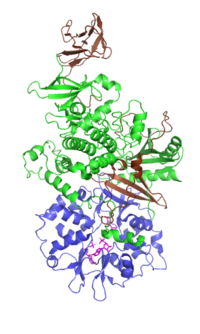
Photo from wikipedia
ABSTRACT Autophagy is a fundamental process that exists in all eukaryotic organisms, with a primary function of catabolizing undesirable components to provide energy and essential materials. Increasing evidence illustrates that… Click to show full abstract
ABSTRACT Autophagy is a fundamental process that exists in all eukaryotic organisms, with a primary function of catabolizing undesirable components to provide energy and essential materials. Increasing evidence illustrates that autophagy is invovled in a broad range of cellular events within the male reproductive system. In the process of spermatogenesis, autophagy is crucial for the formation of specific structures that guarantee successful spermatogenesis, as well as for the degradation of certain constituents. The underlying connections between autophagy and androgen binding protein, lipid metabolism and testosterone biosynthesis would increase our understanding of male testicular endocrinology. Moreover, cumulative studies reveal that autophagy is a double-edged sword when the organism suffers from endocrine disrupting chemicals. This review contains a collection of the current literature concerning the above aspects of autophagy, which may provide insights for future study and exploration. Abbreviations: 3-MA: 3-methyladenine; ABP: androgen-binding protein; AKT: protein kinase B; AMPK: adenosine monophosphate-activated protein kinase; ART: assisted reproductive technologies; Atg: autophagy-related gene; CE: cholesteryl ester; CL: corpus luteum; CQ: chloroquine; CYP11A1: cholesterol side chain cleavage enzyme; CytC: cytochrome C; DEHP: di-2-ethylhexyl phthalate; DFCP1: double FYVE-containing protein 1; EDCs: endocrine-disrupting chemicals; ERK1/2: extracellular signal-regulated kinase 1/2; ES: ectoplasmic specialization; FC: free cholesterol; FIP2000: focal adhesion kinase family interacting protein of 200kDa; FSH: follicle stimulating hormone; HDL: high-density lipoprotein; IVF: in vitro fertilization; LC3: microtubule-associated protein light chain 3; LD: lipid droplet; LH: luteinising hormone; MC-LR: microcystin-LR; MEFs: mouse embryonic fibroblast cells; MT: microtubule; mtDNA: mitochondrial DNA; mTOR: mammalian target of rapamycin; NHERF2: Na+/H+ exchanger regulatory factor 2; NMR: naked mole-rat; PCD: programmed cell death; PDLIM1: PDZ and LIM domain 1; PGCs: primordial germ cells; PGF2α: prostaglandin F2α; PI3K: phosphatidylinositol-3-kinase; PI3P: phosphatidylinositol-3-phosphate; ROS: reactive oxygen species; SCG10: superior cervical ganglia protein 10; SR-BI: scavenger receptor class B, type I; StAR protein: steroidogenic acute regulatory protein; TC: total cholesterol; TEM: transmission electron microscopy; TUNEL: terminal deoxynucleotidyl transferase mediated dUTP nick end labeling; ULK1: mammalian uncoordinated-51-like kinase 1; WIPI: WD-repeat domain phosphoinositide-interacting.
Journal Title: Systems Biology in Reproductive Medicine
Year Published: 2019
Link to full text (if available)
Share on Social Media: Sign Up to like & get
recommendations!